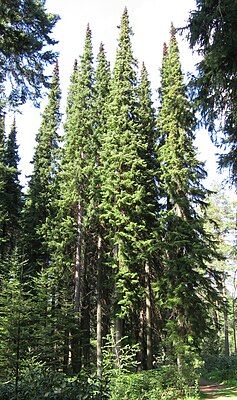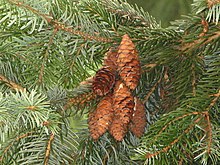Serbian spruce
| Serbian spruce | ||||||||||||
|---|---|---|---|---|---|---|---|---|---|---|---|---|

Serbian spruce ( Picea omorika ) |
||||||||||||
| Systematics | ||||||||||||
|
||||||||||||
| Scientific name | ||||||||||||
| Picea omorika | ||||||||||||
| ( Panč. ) Purk. |
The Serbian spruce ( Picea omorika ), also Omorika spruce (after the Serbian common name for the species omorika / оморика), is a plant species in the pine family (Pinaceae). It occurs only in a small area north of Višegrad . It was first described in 1876 by the Serbian doctor, botanist and first president of the Serbian Academy of Arts and Sciences Josif Pančić, and in Serbia it is called "Pančić spruce" (Pančićeva omorika) in his honor.
description
Habitus
The Serbian spruce reaches heights of growth of 30 to 40 meters, the tallest specimen measured 53 m. The chest height diameter reaches a maximum of 72 centimeters. The maximum age is 160 to 200 years. It forms a very narrow-conical to narrow-cylindrical crown, which can often be stepped pagoda-like due to the symmetrically branched crown. Young trees have a rather broad crown. The branches are short, drooping and have an upturned tip. The trunk is thin and straight as a pin.
Buds and needles
The winter buds are round to pointed ovoid, red-brown and 3.5 to 5 millimeters long. They don't resinify. The terminal bud is often covered by needles. The outer bud scales are lanceolate and pointed, the inner ones are short, egg-shaped and blunt. The flower buds are larger. The needles are flattened dorsiventrally and bifacially. The width is more than five times the height. The stomata are limited to the morphological top. With the side branches, however, the top faces down due to the twisted needle base. The actual underside is therefore silvery gray due to the stomata, the actual upper side is dark green. The needles are close together and have a distinct midrib. The length is 12 to 20 millimeters, the width 1.5 to 2 millimeters. They stay on the branches until 12 years.
Flowers, cones and seeds
The first flowering occurs at the age of 15 to 20 years, the highest seed production occurs at around 40 years. Flowering time is from May to June. Male and female flowers are on a tree ( Monözie ) in the upper crown area. The female cones are red, 1.5 to 2.5 centimeters long and stand upright, laterally to terminally on side shoots. The male flowers are reddish yellow and around one centimeter long and are lateral to the previous year's shoots. The pollen grains are 64.5 µm long, 77.2 µm wide and 55.7 µm high, they carry two air sacs.
In many cases, fertilization occurs through self-fertilization. A growing season passes from flowering to seed maturity. The ripe cones are 4.5 to 6 inches long and 2.5 to 3 inches wide, shiny brown to reddish brown. Their outline is egg-shaped. They hang and some have a short stem. The seed scales are round, 11 millimeters long, 13 millimeters wide and serrated wavy on the edge. The cover scales are very small, not visible from the outside, their edge is sawn. A cone consists of 80 to 110 scales.
When immature, the cones are green and tinged with purple. The seeds ripen in October / November of the first year, after which the cones remain on the tree for up to a year. The seeds are usually only released from spring after the seeds have ripened. Every three to four years there is a fattening year in which up to 3 kilograms of cones are formed per tree.
The seeds are two to three millimeters long and have wings that are around 8 millimeters long.
The seedling has five to six cotyledons with lengths of 10 to 12 millimeters.
The number of chromosomes is 2n = 24.
bark
The bark is gray-brown and rather thin and dissolves in older trees in round scales 6 to 17 centimeters in diameter. It is often covered by droplets of resin , there are many resin canals with a diameter of 1 to 4 millimeters in the cortical parenchyma. Young shoots have dense, short hairs. They carry a multitude of pincushions, their light brown bark is furrowed.
Wood
The wood is similar to that of the common spruce ( Picea abies ). Heartwood and sapwood are the same color. The latewood is a little darker than the earlywood. The wood fibers are single row and there are many resin channels. The bulk density (r 12 ) is 0.5 to 0.52 g / cm −3 . The wood consists of 50% cellulose , 11% pentoses and 25% lignin .
Distribution and location
The natural area of the Serbian spruce is a small area in the border area between Serbia and Bosnia-Herzegovina north of the city of Višegrad in the Tara Mountains on both sides of the Drina . The extension is around 40 kilometers in NW-SE and around 25 kilometers in SW-NE. There are around 50 individual stands between 3 and 3000 trees, the total stand area is around 60 hectares.
The spruces grow at altitudes of 800 to 1400 meters, mostly in mixed stands with Pinus nigra , Pinus sylvestris , Picea abies , Fagus sylvatica , sometimes also Quercus cerris , Carpinus betulus , Populus tremula and Acer campestre . The locations are steep slopes facing north to northwest. The subsoil is predominantly limestone, weathered soils with moderate nutrient and high humus content (little developed rendzinen ). The pH of the soil is neutral. The natural stocks are in a cool summer climate with rather high humidity. The winters are cold and snowy. The precipitation at altitudes up to 1000 m, where most of the stocks stop, is around 1000 mm, evenly distributed over the year. The annual average temperature is 4 to 6 ° C. It is insensitive to late frosts.
The stocks have been severely decimated by forest fires and exploitation, the species has long been in decline.
Diseases and pests
The Serbian spruce was long considered insensitive to air pollutants. However, it is susceptible to sulfur dioxide and hydrogen fluoride . Due to the late budding time, the species is insensitive to late frosts. Snow breaks are mainly caused by wet snow . Especially in areas where the species is being replanted, so-called “Omorika dying” occurs, which is triggered by an accumulation of chlorine ions in the root area. Biotic pests do not pose a serious threat to the Serbian spruce. Red rot is caused by the fungus Heterobasidion annosum . The common honey fungus ( Armillaria mellea ) often attacks the Serbian spruce. The infestation can be so severe that the host tree dies. The letterpress ( Ips typographus ), the striped timber bark beetle ( Trypodendron lineatum ) and the engraver ( Pityogenes chalcographus ) are among the most common bark beetles that attack the Serbian spruce. The sitka spruce louse ( Liosomaphis abietina ) occurs as a leaf pest . The Serbian spruce appears to be resistant to the small spruce sawfly ( Pristiphora abietina ).
use
The Serbian spruce is widely planted in Central Europe as a garden and park tree, where its narrow-crowned, dense needle-like habit that branches to the ground is appreciated. Due to its insensitivity to smoke gases, it is particularly suitable for plantings in industrial and urban areas. In the USA it is used as a Christmas tree. As a forest tree, it is of no importance, as it is inferior to the common spruce in terms of growth.
Systematics
Within the genus spruce ( Picea ), the Serbian spruce is placed in the Omorika section. The Sikkim spruce ( Picea spinulosa ) and the Siskiyou spruce ( Picea breweriana ) are considered to be their closest relatives . A molecular genetic study of the genus could not elucidate the exact relationship of Picea omorika in detail.
Development history
In the tertiary and in the last interglacial period, the ancestors of the Serbian spruce were represented in large areas of Europe. She survived the last Ice Age in retreat areas on the Drina. After the end of the Ice Age, although it has a high seed production and is essentially a pioneer plant, it was no longer able to spread. The main reason is assumed to be that they are less competitive than Picea abies, Fagus sylvatica and Abies alba .
supporting documents
- Peter Schütt: Picea omorika . In: Schütt, Weisgerber, Schuck, Lang, Stimm, Roloff: Lexicon of Conifers . Nikol, Hamburg 2004, pp. 297-305. ISBN 3-933203-80-5
- Threatend Conifers of the World International Resource Program, Royal Botanic Garden Edinburgh - Picea omorika Panc. Purkyne - on the Threatend Conifers of the World Program website of the RBG Edinburgh
Individual evidence
- ↑ http://www.conifers.org/pi/Picea_omorika.php The Gymnosperm Database.
- ^ Tropicos. [1]
- ↑ Steinbach's great plant guide , Ulmer Verlag, ISBN 978-3-8001-7567-3 , page 408
- ↑ Jin-Hua Ran, Xiao-Xin Wei, Xiao-Quan Wang: Molecular phylogeny and biogeography of Picea (Pinaceae): Implications for phylogeographical studies using cytoplasmic haplotypes . Molecular Phylogenetics and Evolution 41, 2006, pp. 405-419. doi : 10.1016 / j.ympev.2006.05.039
Web links
- Picea omorika in the endangered Red List species the IUCN 2006. Posted by: Conifer Specialist Group, 1998. Retrieved on 11 May, 2006.
- Thomas Meyer: Data sheet with identification key and photos at Flora-de: Flora von Deutschland (old name of the website: Flowers in Swabia )

